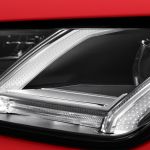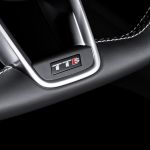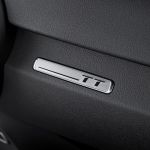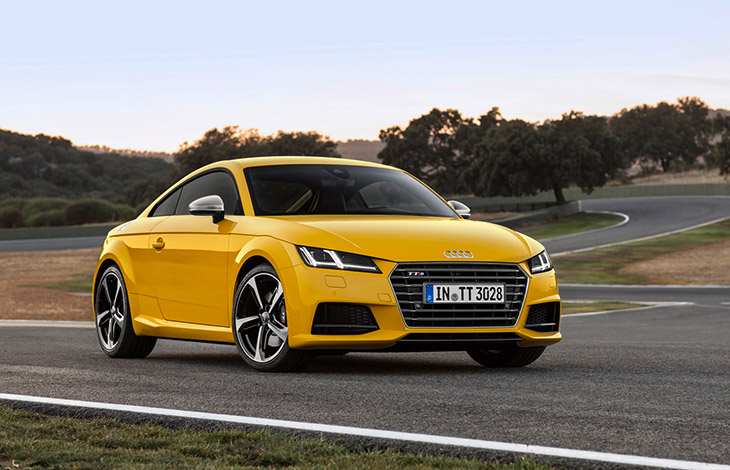
A modern classic relaunched: Audi introduces the latest generation of the TT and TTS. The compact sports car enthralls with dramatic design, pronounced dynamics and groundbreaking technology.
Taut and muscular, athletic and poised to pounce. With the new TT and the new TTS, the Audi designers have delivered a modern interpretation of the unmistakable lines of the original TT from 1998 enriched with numerous dynamic facets. The Coupé is 4.18 meters (13.7 ft) long with a wheelbase of 2.51 meters (8.2 ft) and correspondingly short overhangs.
The front is dominated by horizontal lines. The Singleframe grille is broad and flat; struts structure the interconnected air intakes. The headlights are also structured with dividing struts, which constitute the daytime running lights. Audi also offers the headlights with LED or the innovative Matrix LED technology. The latter uses small, switchable, individual light-emitting diodes to produce the high beam. The dynamic turn signals run in the direction the driver intends to turn, providing additional information for other road users.
When viewed in profile, many details of the TT and TTS are intentionally evocative of the first-generation design classic. The sill contour forms a powerful light edge and the wide wheel arches constitute distinct geometrical entities. At the front, the wheel arch intersects the hood join, which continues over the door as the tornado line and extends all the way to the rear. The flat greenhouse gives the impression of being an independent unit, and the subtle kink in the rear side window emphasizes the C-pillar. The fuel flap in the classic round TT design is press-to-open. There is no longer a cap beneath it – the driver inserts the nozzle directly into fuel tank neck.
In back, horizontal lines again underscore the sporty width of the new TT and the TTS. The struts in the standard LED tail lights, which take up the motif of the headlights and also light up together with the daytime running lights, are another Audi innovation. The third brake light – a flat strip on the edge of the luggage compartment cover – ties together the light silhouette at the rear.
Intelligent composite construction: The body
The composite construction concept behind the body of the TT and the TTS represents a new evolution of the Audi Space Frame (ASF) based on the modular transverse matrix. The front end and the floor of the occupant cell include numerous components of hot-formed steel; the superstructure of the occupant cell plus the exterior skin and all bolt-on parts are made of aluminum. Equipped with the 2.0 TFSI and manual transmission, the Coupé has a curb weight (excluding driver) of just 1,230 kilograms (2,711.7 lb) – up to 50 kilograms (110.2 lb) less than before. This is the second time in a row that Audi has reduced the weight from one TT generation to the next.
The new TT initially will be available with a TDI or TFSI engine. The TTS rolls off the assembly line with the top-of-the-line TFSI. The three forced-induction, four-cylinder engines produce between 135 kW (184 hp) and 228 kW (310 hp), yet consume significantly less fuel than the engines used previously. A start-stop system is standard. A sound actuator works in conjunction with the optional Audi drive select dynamic driving system (standard in TTS) to provide for a sonorous sound.
The TT 2.0 TDI ultra with manual transmission and front-wheel drive delivers 135 kW (184 hp) and 380 Nm (280.3 lb-ft) of torque. Like all of the engines in the new TT, the two-liter diesel fulfills the Euro 6 standard. It averages just 4.2 liters of fuel per 100 kilometers (56.0 US mpg), which equates to 110 grams of CO2 per kilometer (177.0 g/mi) – a new best figure in its segment. The 2.0 TFSI produces 169 kW (230 hp) and 370 Nm (272.9 lb-ft) in the TT; in the TTS, these figures are 228 kW (310 hp) and 380 Nm (280.3 lb-ft). The top model sprints 0 to 100 km/h (62.1 mph) in 4.6 seconds.
In the standard configuration, the 2.0 TFSI is mated to a manual six-speed transmission in both the TT and the TTS, with the six-speed S tronic available as an option. The dual-clutch transmission shifts gears lightning-quick without any noticeable interruption in traction, and in manual mode it can be controlled by paddles on the steering wheel, if desired. In efficiency mode in the Audi drive select system, the S tronic coasts when the driver takes their foot off the gas.
Latest evolution: quattro permanent all-wheel drive
The latest evolution of quattro permanent all-wheel drive is available as an option for the new Audi TT 2.0 TFSI and comes standard in the TTS. Its electrohydraulic, multi-plate clutch sends the power to the front wheels during normal driving, but can divert power to the rear wheels virtually instantaneously upon demand. The electronic control system takes the combination of driving enjoyment and safety to a whole new level. During sporty driving, it is quicker to send the power to the rear axle and thus tends to do so more often, literally pressing the new TT and TTS into the corner. On low-friction surfaces, the quattro drive system allows safe, controlled drifts.
Also new is that management of the clutch has now been integrated into the Audi drive select system (optional in TT, standard in TTS), which offers the modes comfort, auto, dynamic, efficiency and individual. Audi drive select controls the function of the gas pedal and steering boost, and integrates multiple optional modules, including the adaptive damper control system Audi magnetic ride (standard in TTS).
Highly elaborate: The chassis
The Audi TT and TTS feature a McPherson front suspension. Aluminum components reduce the weight of the unsprung masses. The rack of the standard progressive steering is designed such that the ratio becomes more direct with increasing steering input. The four-link rear suspension can process the longitudinal and transverse forces separately.
With its elaborate chassis and firm setup, the new Audi TT offers dynamic, highly precise handling. If the customer chooses the TTS, the S line sport package or Audi magnetic ride, the body is lowered ten millimeters (0.4 in). The TT 2.0 TFSI and the 2.0 TDI roll on 17-inch wheels, each of which weighs only 8.7 kilograms (19.2 lb), and 225/50 tires. The TTS comes with 18-inch wheels and 245/40 tires. Wheels sizes up to 20 inches are available as options.
The vented front brake discs measure between 312 and 338 millimeters (12.3 and 13.3 in) in diameter depending on the engine version. The new electromechanical parking brake acts on the rear wheels. The TTS is equipped up front with newly developed, particularly lightweight aluminum fixed-caliper brakes.
Rounding off the sporty handling is the ESC electronic stabilization control system, which can be partly or completely deactivated. It also functions as an electronic limited slip differential, using carefully modulated braking of the wheel on the inside of the curve, which is under a reduced load, to transfer power to the outside wheel. With quattro drive, this same function is provided by the torque vectoring system, which includes the rear wheels.
Sporty look: The interior design
With its lightweight, almost floating lines, the interior also expresses the sports car character of the new Audi TT and TTS. The interior’s central concept is focused on the driver. All control elements are grouped around the driver. Flowing, corresponding shapes characterize the console of the center tunnel and the door trims. Seen from above, the slender instrument panel resembles the wing of an aircraft; the round air vents – a classic TT feature – are reminiscent of jet engines.
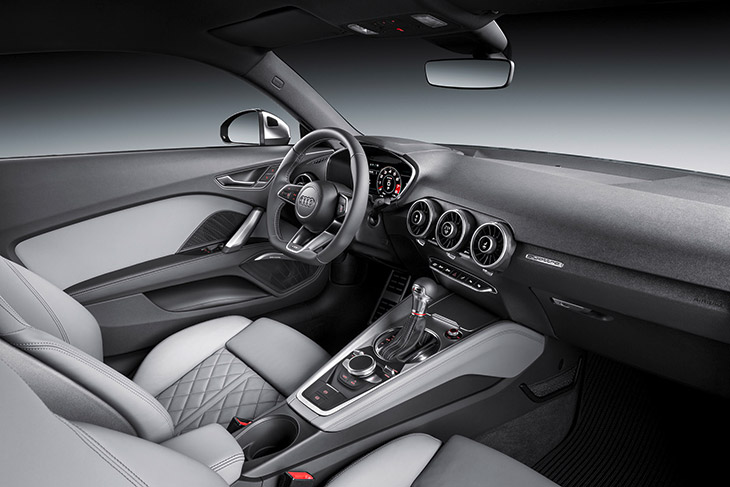
The air vents play an important role in the operating concept. They house the controls for the air conditioning or the optional deluxe automatic air conditioning system. The controls for the heated seats, recirculation mode, temperature, air flow distribution and air flow strength are located on their axes. The air vents are just one example of the high standards to which the premium brand aspires with respect to the function, design and workmanship of all cabin components. Audi has completely revised the range of colors and materials to underscore the sportiness of the new TT and TTS.
The low-mounted sport seats – another new development – together weigh five kilograms (11.0 lb) less than the seats in the previous model. Audi also offers the option of S sport seats with integrated head restraints and deeply sculpted, pneumatically adjustable side bolsters (standard in the TTS).
The 2+2-seat TT is a sports car with a high degree of everyday practicality. The luggage compartment beneath the long rear hatch offers a capacity of 305 liters (10.8 cu ft), 13 liters (0.5 cu ft) more than in the previous model.
New: The Audi virtual cockpit and the operating concept
The Audi virtual cockpit – a digital instrument cluster with highly detailed, versatile graphics – replaces the analog instruments and MMI monitor in the new TT. The driver can switch the 12.3-inch, all-digital display between two different view modes. The classic configuration features the speedometer and the tachometer in the foreground. In Infotainment mode, aspects such as the navigation map move to the forefront and the instrument dials are shown smaller. The TTS includes a view that clearly illustrates the close ties to racing and places the tachometer front and center.
Developed from the ground up, the operating concept is fully focused on the driver. There are two variants of the multifunction steering wheel available. The MMI control element, which is also new, has just six physical buttons. In combination with MMI navigation plus, it includes the MMI smart touch wheel – the touchpad on the top of the rotary pushbutton – with which the driver can do such things as zoom on the navigation map and enter characters. The menu structure was inspired by a smartphone and includes a search function. All key functions can be reached with just a few clicks, and the buttons on the side provide access to intelligently linked functions and options.
Generous: The equipment
Audi will begin delivering the new TT to German dealerships in fall 2014, where it will be available for a base price of €35,000. The list of standard equipment is generous and rounded out by comfort and convenience options such as the convenience key and privacy glass. The range of driver assistance systems extends from the standard rest recommendation to Audi side assist, Audi active lane assist and traffic sign recognition to park assist with 360° display.
Topping the modular infotainment program is MMI navigation plus with MMI touch. The complementary module Audi connect brings the brand’s tailored Internet services to the car via the high-speed LTE (Long Term Evolution) standard. The Audi phone box provides an easy connection for the mobile phone, and the Bang & Olufsen sound system immerses the cabin in sound from twelve speakers.
2015 Audi TTS Coupe
2015 Audi TTS Coupe
2015 Audi TT Coupe
2015 Audi TT
Source: Audi































